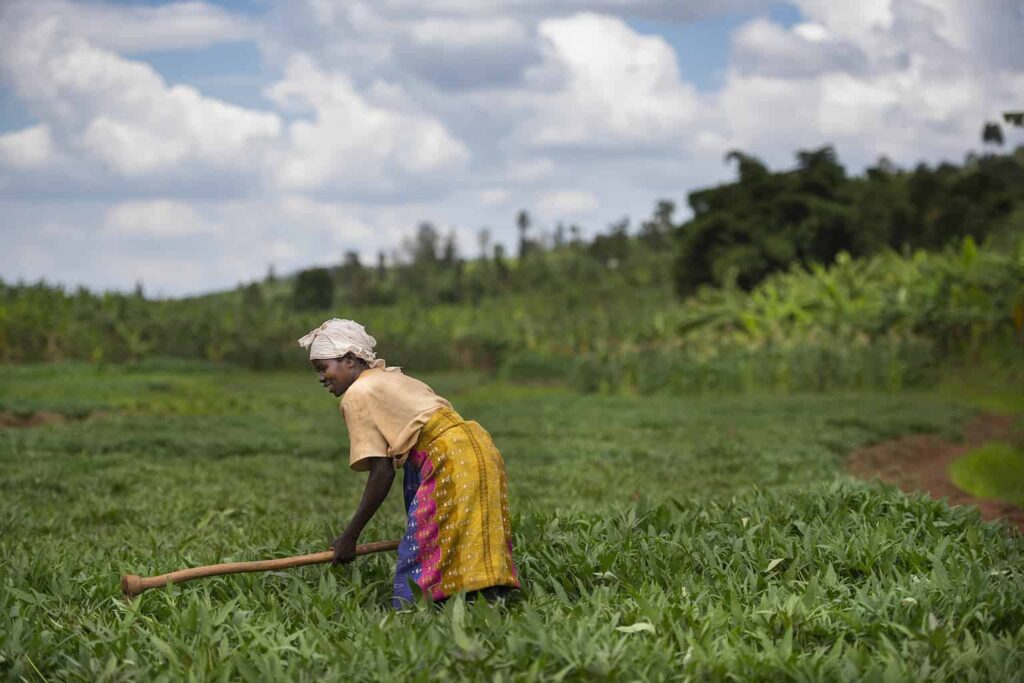Read in
Rwanda farmer (Photo by: Hugh Rutherford for CIP via
A Cambridge-led consortium has secured a $35m grant from Bill & Melinda Gates Agricultural Innovations (Gates Ag One) to engineer plants for better nutrient uptake through micro-organisms, fungi, and bacteria. With Sub-Saharan Africa’s agriculture at risk due to depleted nutrients and a changing climate, the Engineering the Nitrogen Symbiosis for Africa (ENSA) research programme aims to boost crop yields sustainably, addressing poverty in small-holder farming systems. The project will revolutionise smallholder farming without relying on costly and polluting inorganic fertilisers, providing sustainable food production solutions for high-income countries as well.
Challenges of Farming in Sub-Saharan Africa
Sub-Saharan Africa faces numerous challenges in agriculture. One significant issue is the low agricultural productivity, which results in hunger, poverty, and biodiversity loss[4]. Small-scale farmers in the region struggle with depleted nutrients in the soil, making it difficult to maintain healthy crop yields[1].
Artificial fertilisers are often too expensive for small-scale farmers, and their livestock numbers are too low to produce sufficient manure to nourish their crops[1]. As a result, crop yields in Sub-Saharan Africa are lower than those in countries like the United States[1]. Additionally, climate change is intensifying food insecurity in the region, with unpredictable weather patterns and more frequent extreme events negatively impacting crop and livestock yields[8].
Furthermore, African farmers account for only 4% of global fertiliser consumption, facing high costs and accessibility issues[3]. The limited access to local markets and inadequate infrastructure also contribute to the region’s low productivity[4].
ENSA Project: A Sustainable Solution
The ENSA research programme aims to address these challenges by engineering plants that can better utilise nutrients from the air and soil through symbiotic relationships with micro-organisms, fungi, and bacteria[1]. By optimising these interactions, ENSA hopes to increase crop yields sustainably, benefiting both smallholder farmers in low-and-middle-income countries and providing a viable solution for sustainable and secure food production in high-income countries[1].
ENSA is a collaboration between several international universities and research institutions, including institutions from the UK, Denmark, the Netherlands, Germany, France, and the USA[1]. With the support of Gates Ag One, the project focuses on six priority food crops: cassava, cowpea, maize, rice, sorghum, and soybean[3].
One of the main objectives of the ENSA project is to replicate the ability of legumes to naturally accommodate soil bacteria for nitrogen conversion into ammonia in cereals. This could increase the yields of staple foods sustainably, without the need for artificial fertilisers[3].
Impact of ENSA on Sub-Saharan Agriculture
The ENSA project has the potential to revolutionise smallholder farming in Sub-Saharan Africa by providing an environmentally friendly and cost-effective solution to increase crop yields. By improving nutrient uptake through natural symbioses, ENSA can help address the challenges of depleted soil nutrients and climate change impacts on agriculture in the region, contributing to poverty alleviation and food security[1][4].
Moreover, the project can also support sustainable intensification (SI) of agriculture in the region, which is crucial for long-term agricultural policies in Sub-Saharan Africa. SI combines increased crop productivity and profitability with the sustenance of key ecosystem services and stability of production against shocks and stresses such as climate change[7]. By focusing on yield increase with a high return on investment for smallholders, ENSA can drive an agronomic revolution supported by big data, remote sensing, and digital tools[7].
Overall, the ENSA project holds great promise for the future of agriculture in Sub-Saharan Africa, offering a sustainable and innovative solution to boost crop production and address the region’s pressing challenges.
source:Inovationorigins



